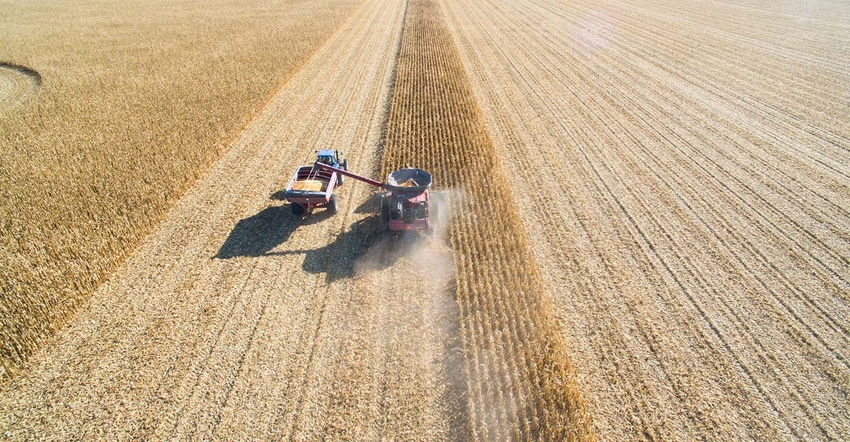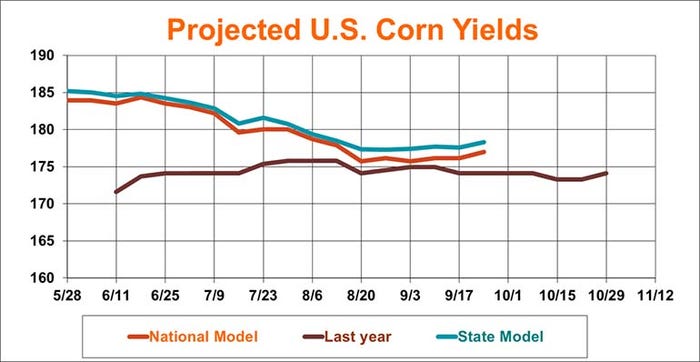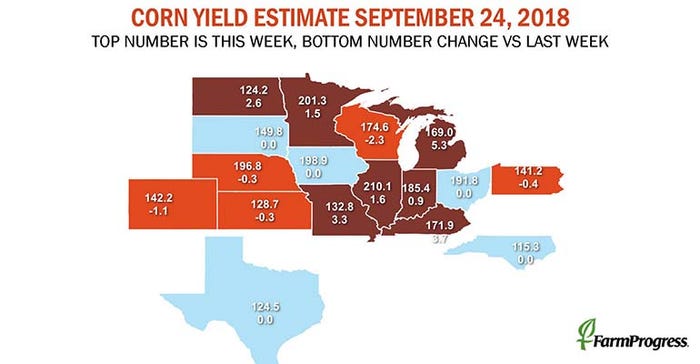
If combines aren’t already rolling near you, chances are they will be soon, according to the latest USDA Crop Progress report.
USDA has the 2018 U.S. corn harvest at 16% complete for the week ending September 23, moving ahead from 9% the prior week. That’s a bit faster than normal, with 2017’s progress reaching 10% at the same time last year, with a five-year average of 11%.
And the rest of this year’s crop will be ready for harvest soon enough, with 97% reaching dented stage and 72% last week. Both crop stages are progressing moderately ahead of 2017’s pace and the five-year average.
Of the top 18 corn-producing states in the U.S., seven have reached harvest progress of at least 25% or more – including Illinois (28%), Kansas (30%), Kentucky (50%), Missouri (43%), North Carolina (76%), Tennessee (60%) and Texas (67%).
As for crop quality, USDA rates 69% in good-to-excellent condition, up a point from last week’s rating of 68%. Analysts anticipated no changes between last week and the prior week. Another 19% of the crop is rated fair (down from 20% the prior week), with the remaining 12% rated poor or very poor (unchanged from the prior week).
Soybean harvest reached 14% complete as of September 23, up from 6% the week prior and ahead of 2017’s pace of 9% and the five-year average of 8%. Southern states Louisiana (66%) and Mississippi (47%) lead the charge so far.
And 71% of the U.S. soybean crop is now dropping leaves, up from 53% the prior week, and ahead of 2017’s pace of 60% and the five-year average of 57%.
USDA also added a point to soybean crop quality, moving it from 67% in good-to-excellent condition for the week ending September 16 to 68% last week. Analysts expected the agency to make no quality adjustments. Another 22% of the crop is now rated fair (down from 23% the week prior), with the remaining 10% rated poor or very poor (unchanged from the prior week).
Farm Futures senior grain market analyst Bryce Knorr says estimates of both corn and soybean yields improved this week, although forecasts made from crop ratings remain below the records projected by USDA.
“The most noticeable feature on this week’s yield maps is the big drop in North Carolina due to floodwaters from Hurricane Florence,” he says. “Our yield projection for the state dropped 4.3 bushels per acre, on top of a decline of nearly 2 bpa last week. Harvest had just begun in North Carolina before the storm, leaving soybeans vulnerable. Corn yields were steady after a drop of nearly 6 bpa the previous week, but production was already hard hit by adverse weather earlier in the growing season.”
Aside from that, most states showed improving soybean yields, with models ranging from 50.9 bpa to 51.7 bpa, Knorr adds.
“And for corn, the average projected yield based on ratings was up eight-tenths of a bushel, with the yield estimates ranging from 177 to 178.3 bpa,” he says.
With spring wheat harvest effectively complete, USDA turns its sights to the 2018/19 winter wheat planting season and notes progress of 28%, up from 13% a week ago. That pace comes in slightly faster than 2017’s pace of 22% and the five-year average of 26%.
Other harvest progress of note:
Sorghum harvest progress reached 30% (up from 26% the prior week).
Sugarbeet harvest progress reached 16% (up from 12% the prior week).
Peanut harvest progress reached 10% (up from 3% the prior week).
Cotton harvest progress reached 16% (up from 13% the prior week).
Rice harvest progress reached 65% (up from 49%) the prior week).




About the Author(s)
You May Also Like






